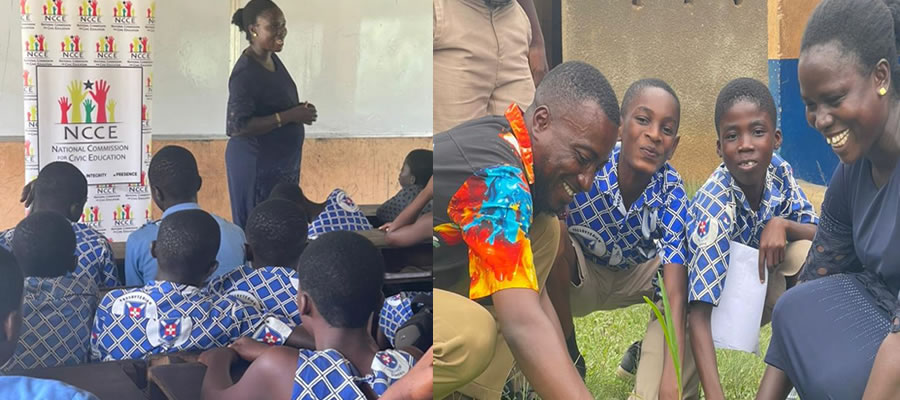

The Kwaebibirem district is made up of six (6) zones called sub-districts where various health staffs and Community Health Volunteers in conjunction with communities work together to provide essential care through the following health facilities;
DISTRIBUTION OF HEALTH FACILITIES IN KWAEBIBIREM DISTRICT | ||
Facility | Number | Location |
Hospitals | 2 | St. Dominic’s GCG |
Health Centers | 4 | Asuom, Takorase, Kade, Pramkese |
RCH | 5 | Kade, Otumi, Pramkese, Asuom and Takorase |
CHPS | 6 | Okumening, Boadua, No 4, Okynso, Kwae, Larbikrom |
outreach |
| All over the district |
Private clinics | 7 | Adorn Clinic, St. Michael, Takyiman Clinic, Salvation Army ,Dwenase Fame Clinic, University clinic, and GOPDC clinic |
Drug stores | 96 | All over the district |
Apart from the above routine activities, the following special programs / projects are run in the district: Global malaria control, Guinea worm eradication. National TB control, eye care services, IMCI, Insurance scheme, CHPS.(Community Based Health Planning Services).
It was the target of the district to reduce child mortality to the barest minimum.
BCG-100% of total children under 1 year (7792) children.
These are group of diseases that mostly kill children under five years. Since we want to reduce both morbidity and mortality in these children, prescribes were trained in management of IMCI. The table below shows the trend of IMCI diseases for the past three years. At OPDs, RCH Centres, outreaches, clients were educated on these diseases so that they could help in early identification, reporting and management to reduce morbidity and mortality among children under five years.
Number of children | weighed during |
| |
SUB DISTRICT | 0-11 MONTHS | 12-23MONTHS | 24-59 months |
KADE | 1694 | 722 | 194 |
AKWATIA | 4041 | 1349 | 841 |
PRAMKESE | 970 | 543 | 330 |
ASUOM | 1921 | 319 | - |
TAKORASE | 1058 | 571 | 420 |
OTUMI | 600 | 496 | 394 |
TOTAL | 12,084 | 4000 | 2179 |
HIV/AIDS
Available figures from the District Health Administration showed that 12 persons were diagnosed with HIV/AIDS in 1988. Additional 50 cases were recorded in the year 1999. 83 new cases of HIV/AIDS were recorded in the year 2000, and 107 cases was recorded for the year 2001. By the close of 2002 a whopping 286 cases had been recorded, 333 cases in 2003, 452 cases as at the end of 2004 and 434 as at August 2005 and 139 as at June 2006.
The most affected age group is 19-49 years. An average of 38 persons was infected every month in 2004 as against 19 in 2003. At least one person is infected every day in the District. Records also show that more women were infected more than men. This is indicated in the table below
Table 1.34 Recorded HIV/AIDS cases among men and Women of various age groups in Kwaebibirem District in 2003 &2004
year | 0-4 | 5-9 | 10-14 | 15-19 | 20-24 | 25-29 | 30-34 | 35-39 | 40-44 | 45-49 | 50-54 | 55-59 | 60+ | * |
male | 4 | 0 | 0 | 0 | 4 | 11 | 18 | 22 | 17 | 7 | 6 | 2 | 2 | 3 |
female | 9 | 0 | 0 | 2 | 12 | 20 | 26 | 24 | 12 | 15 | 2 | 4 | 4 | 3 |
Almost all communities are affected but the worst affected communities are: Akwatia, Adankrono, Kwae, Asuom, Kade, Takrowase, Wenchi, No. 4 (Nkwankwakrom) and Boadua
Support Given to Persons Living with HIV/AIDS (PLW HA)
Dominic’s Hospital, Akwatia continue to be the sole body that supports persons with HIV/AIDS and their families. These are mainly in the form of feeding, transport cost and engaging them in social activities such as playing "Oware" draught, Ludo and Cards. Counseling services are also provided to patients.
Catholic Relief Services and the Kwaebibirem District Assembly have supported an association of people living with HIV AIDS called "in God We Trust" with seed money for income generating activities.
Population Management
The Government of Ghana in 1969 adopted a population policy titled "Population Planning for National Progress and Prosperity."New emerging concerns such as HIV/AIDS, environmental degradation, problems of the aged etc have necessitated the revision of the policy. Again the Ghana Poverty Reduction Strategy (GPRS II) 2006-2009, the country’s framework for Poverty Reduction is concerned with population issues within the context of reducing poverty among people. The District is guided by this policy in managing its population.
Fertility Regulation
To make the population manageable the District has instituted campaigns on fertility regulation to reduce the high fertility rate. All health facilities in the District are involved in fertility management especially of women aged 15-49 years. At the health facility level clients are counseled on the range of fertility regulation devices and also on the most appropriate method of family planning.
Campaigns have been organized in schools, communities and among religious groups. The Planned Parenthood Association of Ghana (PPAG) in Collaboration with the District Health Administration has recruited community-based distributors who issue out condoms to clients and counsel them on family planning techniques.
Health Care
The health delivery system in the Kwaebibirem District consist of 2 hospitals, 4 health centers, 3 community clinics, 1 maternity home, and 6.RCH centers and 4 CHPS centres. In addition to the above, outreach clinical activities are organized in most communities, which lack established health facilities.
The district’s doctor-population ratio is 1:118 whilst the nurse-population ratio is 1:1519. The doctor population ratio of 1:28190 is higher than the national and WHO ratios of 1:25,000 and 1:10,000 respectively. The location and management of the various health facilities are shown in table 1.22 refer to pdf file
The Mission hospital, located at Akwatia, is the most well equipped health institution in the district, which serves as a referral center for the other lower health institutions. The district has 10 medical doctors, 148 nurses, 5 medical assistants, 55 orderlies and 12 health Aides and other paramedics like laboratory technicians etc.
The threshold analysis in table 1.23 indicates that the district needs an additional 6 health centers and 22 community clinics to make the physical access to health facilities easier and most convenient. In addition to the provision of these health infrastructure, health personnel and equipment need to be increased and improved to ensure quality health delivery in the district.
It is envisaged that the Health Centre at the District Capital, Kade will be upgraded into a hospital in the near future.
Maternal and Child Health (MCHVFamily Planning (FP) Activities.
The main activities of the MCH/FP carried out in the district are geared towards child survival and development and the health of mothers. The reproductive health situation from 2001 - 2005 is shown in table 1.37 below
indicator | 2001 | 2002 | 2003 | 2004 | 2005 |
ANC | 1893 | 7454 | 7003 | 6424 | 7803 |
PNC | 2882 | 3464 | 3936 | 3967 | 4134 |
CYP Family planning | 8.6 | - | - | - | - |
EP Acceptor Rate | 7087 | 6823 | 13165 | 1458 | 18213 |
Supervised Deliveries | 4260 | 4490 | 4100 | 4209 | 4193 |
total Teenage Prenancies | 1368 | 1327 | 1075 | 914 | 1106 |
Source: DHMT September 2006
vaccine | 2002 | 2003 | 2004 | 2005 | 2006 Half Year |
BCG | 8253 | 8701 | 9003 | 9801 |
|
Measles | 6786 | 7802 | 9411 | 8726 |
|
OPV3 | 6153 | 6609 | 6397 | 7501 |
|
DPT3 | 6176 | 6581 | 6328 | 7521 |
|
TT2 | 5533 | 5171 | 4751 | 4801 |
|
YF | 6296 | 7304 | 7263 | 8738 | 4063 |
Source: District Health Administration Kade July 2006
Immunization activities are curried out daily in the hospital and health centers and MCH centers in the district. In addition to this, outreach programmes organized by the Mobile Teams bi-weekly in the smaller settlements to cater for the health needs of mothers and children. As shown in the above Table there has been a consistent improvement in the coverage of the four six-killer diseases from 2001-2005.
Reported Cases of Diseases
Malaria continues to place in first in both OPD and admission cases, even though there was a decrease from 37,807 in 2004 to 24,511 in 2005. This was followed by other diseases as indicated in the table below. Preventable diseases like accidents continuous to rise also in the district. This shows that the necessary occupation safety measures are not adopted in both works places and on the roads.
District Mutual Health Insurance Scheme
The Kwaebibirem District Assembly is one of the few districts in the country to start the programme in the country in the year 2004. It started with 2867 members in its first year of implementation. During the second year, the figure jumped to 41816 and currently, 2006 it has a membership of over 75,000.
Beneficiary can accessed the scheme, from a number of hospitals and clinics among which are; St. Dominic’s Hospital, G.C.D. Hospital, Oda Gov’t Hospital, Kade Health Centre, Asuom Health Centre, Takrowase Health Centre, Pramkese Health Centre, GOPDC Clinic, Salv. Army Clinic, Akim Wenchi.
The performance of the District MutuakHealth Insurance Scheme is highly commendable in comparison to other schemes in the region in the whole country. This notwithstanding, the scheme is face with some problems which is hindering its performance. These are: lack of permanent office accommodation, lack of official vehicle and inadequate staff to successfully implement the programme in all nooks and cranny of the district.
Health
1. High incidence of HIV/AIDS
2. Inadequate support for people living with HIV/AIDS (PLWHA)
3. High facility rate
4. Inadequate Health facilities
5. High incidence of malaria
6. Poor condition of Health Infrastructure
7. Inadequate Health delivery
8. Poor nutritional status
9. High cost of Health Care
10. Inadequate Health Personnel
11. Inadequate accommodation of Health Personnel
12. Inadequate equipment/logistics
13. Inadequate supply of potable water
14. Inadequate liquid/solid waste managements facilities
15. Poor waste management practices
16. Poor drainage system
17. Inadequate toilet facilities
Date Created : 11/24/2017 7:11:50 AM












 facebook
facebook
 twitter
twitter
 Youtube
Youtube
 +233 593 831 280
+233 593 831 280 0800 430 430
0800 430 430 GPS: GE-231-4383
GPS: GE-231-4383 info@ghanadistricts.com
info@ghanadistricts.com Box GP1044, Accra, Ghana
Box GP1044, Accra, Ghana